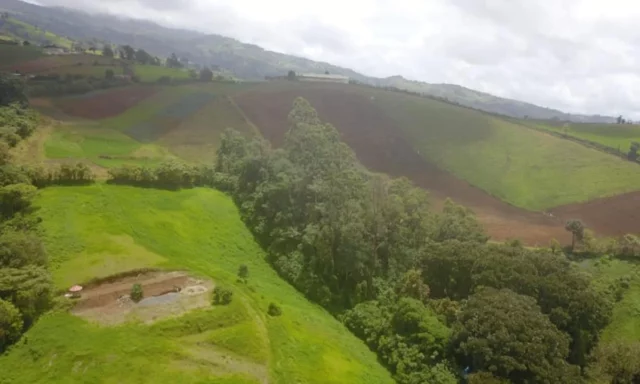The metabolites of the fungicide Chlorothalonil are present in an amount of 19.36 micrograms per liter, when the limit is 0.1, according to the Regulation for the Quality of Drinking Water for pesticides in Costa Rica.
An analysis carried out by the National Water Laboratory of the Costa Rican Institute of Aqueducts and Sewers (AyA) confirms that the water from the Plantón and Carlos Calvo springs, which supply the community of Cipreses, in Oreamuno de Cartago, contains derivatives of the fungicide Chlorothalonil in amounts above the maximum allowed.
According to the result of the water sample taken on September 26, 1,3-dicarbamoyl-2,4,5,6-tetrachlorobenzene (derived from Chlorothalonil) is present in the nascent Plantón in an amount of 19, 36 ug/L (micrograms per liter), when the presence of these chemicals must be less than 0.1 ug/L. While in the Carlos Calvo spring it is present in an amount of 1.73 ug/L.
The results carry the code AYA-FPT-011B and are signed by the head of the Chemistry Laboratory Luis Zúñiga Zuñiga and approved by Darner Mora Alvarado, director of the Laboratory.
In an official letter sent by Carlos Ramírez Vallina, from the AyA Rural Aqueduct Management Unit, it is indicated that “the results obtained confirm that the levels of metabolites are above the parameter established by the Regulation for the Quality of Drinking Water for pesticides , which is 0.1 ug/L”. The letter was sent on October 25 to the AyA legal office.
On October 20, the Ministry of Health ordered Virgilio Ulloa Ulloa, president of the ASADA, to immediately close the Plantón and Carlos Calvo sources, due to the lack of information on health risks presented by the presence of derivatives of the fungicide. Chlorothalonil in the water.
The Ministry of Health also ordered AyA to provide water to the community immediately, “by means of tank trucks or any other mechanism that ensures the availability of safe water for human consumption.”
Reaction from the Eco Cipreses Front
The Plantón and Carlos Calvo springs supply a population of more than 2,500 people in Cipreses, an eminently agricultural community.
According to information from the Regional Institute for Studies on Toxic Substances of the National University (IRET-UNA), Chlorothalonil is a fungicide that is used on vegetables, celery, coriander and onion, among others. It is the second largest imported fungicide in the country, although it has been banned in 32 countries, as it is considered a highly dangerous pesticide due to its chances of causing cancer.
Fabián Pacheco, a member of the Cipreses Ecological Front -made up of residents of the area- declared: “What we feared is confirmed. It is a reality that the water is contaminated with Chlorothalonil products. And what worries us most is what is going to happen to the water in our community, how long does a decontamination process like this take? And we do not see measures being taken to stop planting in the aquifer recharge area at this point with these results. The more time passes and they continue to apply Chlorothalonil on the aquifer recharge area, the more time it will take to decontaminate the water. Not only human life is affected but aquatic life and wildlife.”
Pacheco explained that these results confirm what they had been pointing out since last year in several press conferences, when they presented the results of analyzes carried out by IRET-UNA, which they had not wanted to be recognized by the authorities. The results of the IRET-UNA confirmed, had been contrasted by analysis of laboratories in Switzerland.

Unhealthy situation
“This truly marks a before and after, that the institutions have confirmed, accepted, these results in Cartago; it had never happened. It sets a very strong precedent for everyone. It makes everyone, farmers, Asadas, institutions, the population in general, ranchers, soak their beards and perhaps here is one of the answers as to why Cartago is one of the places with the highest rate of gastric cancer in the world,” said Pacheco.

For those who have experienced shifts in consciousness and know that more peace, joy, and love awaits in a better living environment. A bold shared vision. A living community and hub for innovation. A sustainable ecosystem for living and working. A model for the new future.
